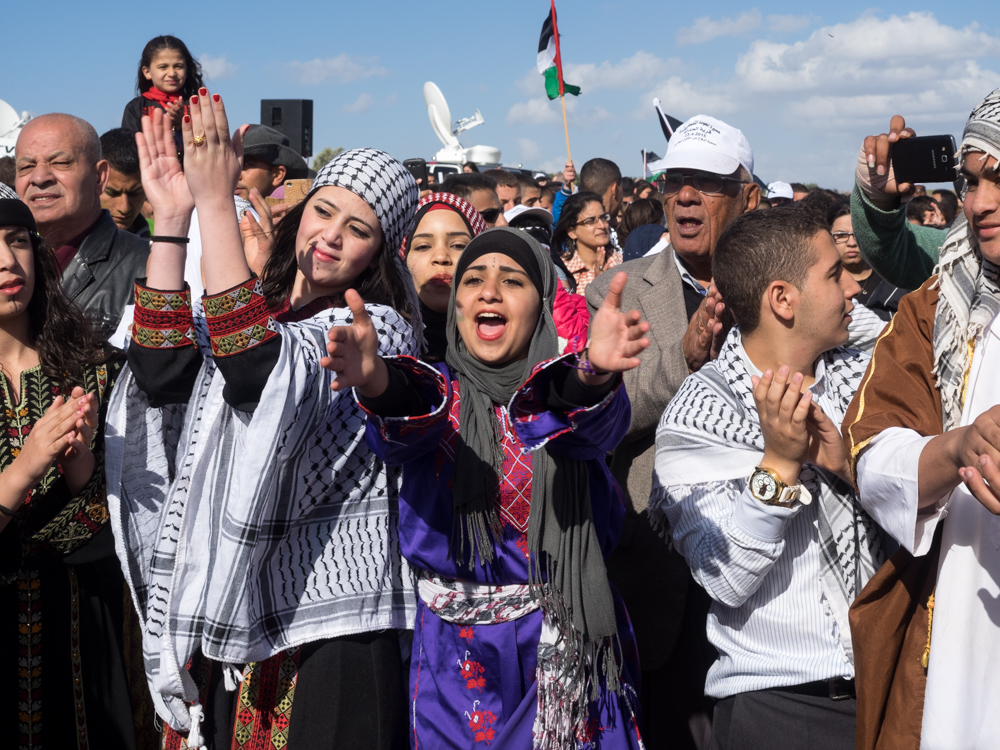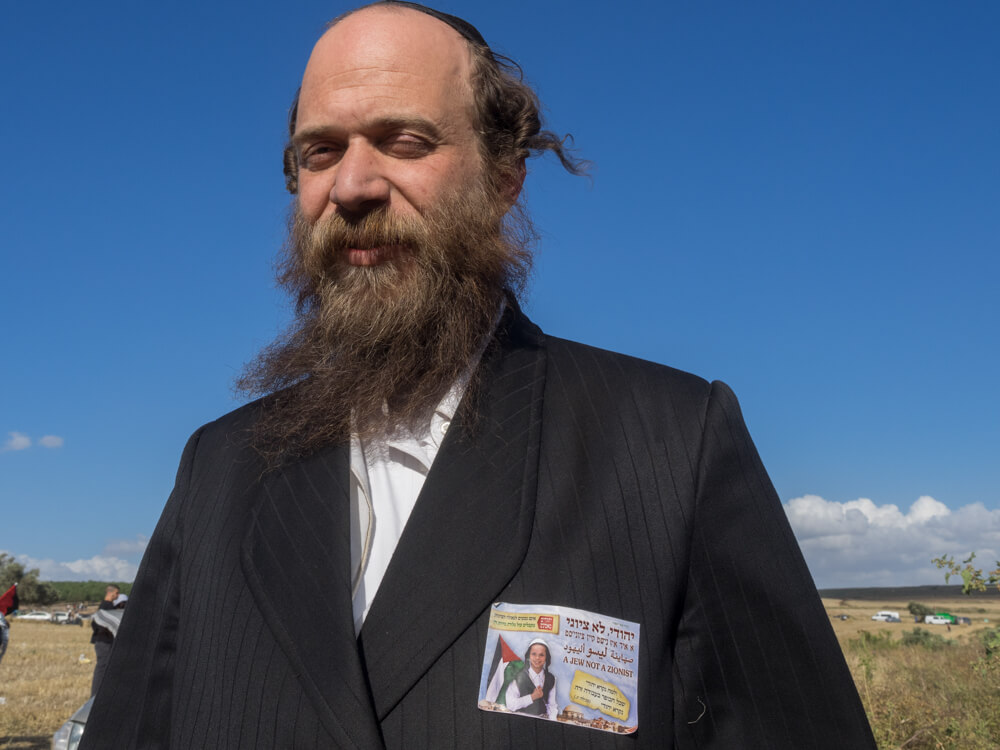Yesterday, an estimated 5,000 Palestinian citizens of Israel and Jerusalemites participated in the March of Return in an open field overlooking the Sea of Galilee and above a valley where ruins of the village of Hadatha are scattered. Organized annually by the Association for the Defense of the Rights of the Displaced People, the March of Return commemorates the ethnic cleansing of Palestine — what is known as the Nakba.
Unseasonably cold weather, biting wind and rainclouds made for a smaller turnout than last year’s event. The atmosphere of the event was festive — featuring art exhibitions, a dabke troupe and men on stilts — but some battled a sense of hopelessness. lt was shortly after the March of Return last year that Mohammed Abu Khdeir was brutally murdered, which lead to Israel’s devastating 51-day war on the Gaza Strip. And following his re-election last month, Prime Minister Benjamin Netanyahu is now poised to form Israel’s consecutive most right-wing government in history.
“Last year was better, but not only because there were many more people,” said Tarek Bakri, who I met at last year’s March of Return in Lubya. “We’re bored with speeches. We need a vision or a strategy. We’re going to a demonstration but what do we do next?”

Having spent two months tending to children in hospitals who were maimed by Israeli airstrikes in the Gaza Strip, Bakri acknowledged the psychological toll it took on him. Yet it is the sight of children waving the Palestinian flag and the elderly that motivates him to not abandon hope. “As a young man, walking this distance tires me. But when I see someone who is 70 years old, I imagine the refugees who walked to Lebanon, Syria and Jordan in 1948 and I forget about the exhaustion.”

Members of Knesset of the recently formed Joint Arab List party, Ayman Odeh, Ahmad Tibi and others were present at the march. Yet they do not represent Palestinians from East Jerusalem such as Tarek Bakri who are barred from voting in Israel’s national elections. Despite this apartheid policy, he closely follow the Israeli government’s political developments. “I have to know what is happening down the street in the Knesset because it affects our lives.” As Netanyahu’s upcoming coalition is expected to be more right-wing than ever, many anticipate a deluge of laws that target Palestinians, such as the recently passed absentee property law which allows the Israeli government to seize Palestinian property in East Jerusalem. Facing this reality, Bakri is skeptical. “They are going to try but it’s going to be a big challenge with this new right-wing government,” he said.
Israeli farmer Nimrod Ayali, 33, stood aside as hundreds of Palestinians marched by him between fields of olive trees. “I understand what they are doing — I respect that,” he told me. “I see the ruins of the villages that used to be here.”

As dabke blasted from the speaker system, 40-year-old Mordechai Mintzberg, an Orthodox Jew from Jerusalem who attended the March of Return in solidarity spoke with Asmaa Hijazi, 18, from Tamra, a Palestinian village near Akka.
“My family has lived here for eleven centuries. There was peace until the Zionists came — that’s what made the conflict,” Mintzberg explained. “What connects Jews is the Torah, not the country. The Zionist movement isn’t about Judaism, it’s about European colonization. Israel says it’s a Jewish country but it’s not Jewish!”

The polite conversation between Mintzberg was inspiring for Hijazi. “It’s gives me hope to talk to Jews who understand and support us,” she said. Like Tarek Bakri, Hijazi has struggled with maintaining hope after the deadliest year for Palestinians since the occupation began in 1967. “We want to be here and to fight because we can’t do much for people in Gaza. It’s really hard to live here when there is a war because you know which side you are on but you can’t do anything about it. Sitting at home and watching the news without taking action is a horrible feeling.” For Hijazi, the worsening of the situation for Palestinians makes it that much more crucial to demonstrate. “It’s important to be with the people here to remind ourselves that we are connected, what we belong to and what our story is.”




Dan Cohen — In the text you refer to Mordechai Mintzberg, but in the caption of the pictures you call him Mordechai Mintzinger.
Please indicate which is correct, as I would like to use his statement and quote the proper person.
It has always irked me when I hear people say that the I/P issue is an “ancient” struggle. No, it isn’t. It only dates back to the late nineteenth century when a bunch of white Europeans decided to make for themselves a colonial outpost in Palestine and take the land from the native inhabitants.
The lead paragraph defining the Nakba as “the ethnic cleansing of Palestine by pre-state Zionist forces in 1947-1948” gives an entirely incorrect impression that it was conducted by private militias whereas it was a policy pursued also by the organised might of the Israeli army continuing after the creation of the state in May 1948. For instance Operation Danny in July 48 drove 100,000 (according to Benny Morris) from Ramlah and Lydda, and Operation Hiram in October 48 captured and partially cleansed the entire Galilee region.
It is unusual for journalists normally as scrupulous as Dan Cohen to present such obviously false information on Mondoweiss.
Video of Israel’s bullies in uniform attacking members of the media. Protesters beware they are on the loose over there.
http://www.haaretz.com/news/diplomacy-defense/1.653430